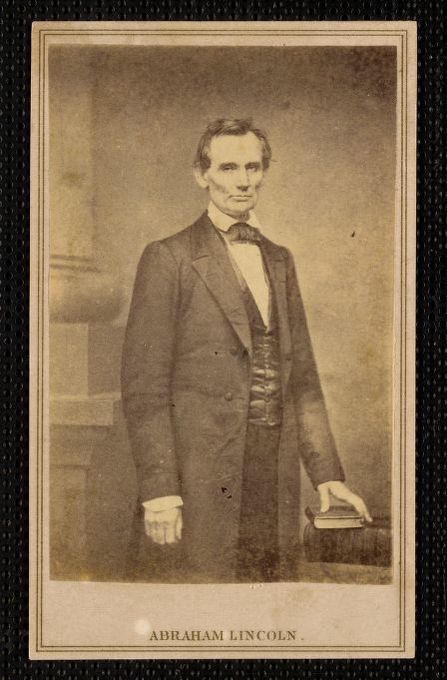by Jim Garrison

After his return from Crimea, Richard McCormick published two books from his experience overseas: A Camp Before Sevastopol and St. Paul’s to St. Sophia. During the Civil War, Richard McCormick began to follow and cover the battles of the Army of the Potomac. Along with Henry Raymond of the Times, McCormick was one of the few war correspondents following the Union that had any previous experience in the battlefield.[1] After the war, he became an editor for the Evening Post and Young Men’s Magazine.[2] By 1863 he would go on to become Second Territorial Governor of Arizona where he substantially influenced the development of the Territory.
In 1860 he met Abraham Lincoln who was running for the Republican nomination. When Lincoln came to New York to deliver his speech at the Cooper Institute, McCormick met with him to facilitate publishing the speech in the Evening Post. Since Lincoln had only been to New York once before, McCormick offered to show him around the city and even accompanied him for his professional photograph before the event.[3]
They became good friends over the next few years. After McCormick became Chief Clerk of the Department of Agriculture at Washington, he frequently visited the White House. Richard McCormick ran for the Long Island District congressional seat but was not elected, which he later attributed to his loyalty to the Lincoln administration.[4] His loyalty was rewarded, however, in 1862 when Abraham Lincoln appointed McCormick as the first Territorial Secretary of Arizona.[5] He heavily advocated for the development of the Arizona territory citing its rich resources. In an 1864 letter to John G. Nicolay, President Lincoln’s private secretary, McCormick wrote about the election and his political opponent; he described the area as “vastly rich in minerals” and detailed a “promising silver lode” he had been looking into.[6] He served in this position until the Territorial Governor of Arizona was elected into congress, making McCormick acting governor until he was officially appointed by President Andrew Johnson in 1866.[7]
Richard McCormick married his first wife Margaret Griffiths Hunt on September 27, 1865, in New Jersey.[8] Her journal recorded their journey from New York, around Cape Horn, to Los Angeles. From there, they crossed the Mojave to the territorial capital of Arizona, Prescott. They lived together with the governor and other officials in the Governor’s Mansion. In letters to her brother, Hunt described the parties she threw at the Governor’s mansion, the few non-labor intensive job opportunities in Arizona, and increasingly violent confrontations with Native Americans.[9] She died during childbirth at the young age of 23 along with her newborn on April 30, 1867.[10] The entire population of Prescott attended her funeral where she and her child were buried outside the Governor’s Mansion. McCormick would go on to marry Rachel Thurman in six years later.[11]
While in Arizona, McCormick accomplished several firsts in the territory. He brought along a printing press and created the first Arizona newspaper: the Arizona Miner which was released monthly. This same printing press also printed the first codification of Arizona’s laws, the Howell Code. McCormick also sold to the territory a large number of books that provided the start of the Arizona state library.[12] He also designed the first territorial seal, assigned school districts, advocated for the expansion of railways and telegraph lines, and appealed to the federal government for more military involvement in the conquest of the Apache.[13]
Governor Richard C. McCormick died from a stroke in New York on June 2, 1901. He left behind a powerful legacy. Having traveled much of Europe following the Crimean War before he followed Union Soldiers through the American Civil war, he saw plenty of action in his lifetime. After the war, he developed a close friendship with President Lincoln. After he was appointed Territorial Secretary, he dedicated the rest of his life to the development of the Arizona Territory and contributed so much to its early capital of Prescott and the surrounding country.
Notes
[1] Brayton Harris,In War News: Blue & Gray in Black & White: Newspapers in the Civil War,(Charleston, SC: Brassey’s, 2010), 68–69.
[2] Williams, “The Territorial Governors Of Arizona-Richard Cunningham McCormick.”
[3] Richard McCormick, “Interesting Reminiscences,” New York Evening Post, May 3, 1865
[4] Arizona Archives Online. “Richard and Margaret McCormick Papers, SHM MS-35”; Richard McCormick, “Interesting Reminiscences,” New York Evening Post, May 3, 1865
[5] Arizona Archives Online. “Richard and Margaret McCormick Papers, SHM MS-35.”
[6] Abraham Lincoln, Abraham Lincoln papers: Series 2. General Correspondence. 1858 to 1864: Richard C. McCormick to John G. Nicolay, Friday, Affairs in Arizona Territory. 1864. Manuscript/Mixed Material. https://www.loc.gov/item/mal4294100/.
[7] Williams, “The Territorial Governors Of Arizona-Richard Cunningham McCormick.”
[8] Norm Tessman, “The personal journal and Arizona letters of Margaret Hunt McCormick.”
[9] Tessman, “The personal journal and Arizona letters of Margaret Hunt McCormick.”
[10] Arizona Archives Online. “Richard and Margaret McCormick Papers, SHM MS-35.”
[11] Arizona Archives Online. “Richard and Margaret McCormick Papers, SHM MS-35.”
[12] Williams, “The Territorial Governors Of Arizona-Richard Cunningham McCormick.”
[13] Arizona Archives Online. “Richard and Margaret McCormick Papers, SHM MS-35.”